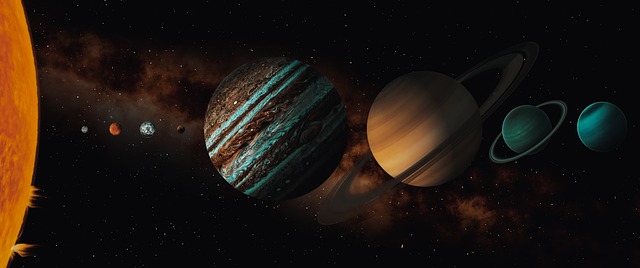
Our Solar System holds a place of undeniable awe and wonder. Nestled within the Milky Way galaxy, it is a captivating tapestry of celestial bodies that has captivated the imagination of humanity for centuries. With the Sun, our radiant parent star, at the center of this grand cosmic ballet, the Solar System encompasses a mesmerizing array of planets, moons, asteroids, and comets. Each celestial body possesses its own unique allure, beckoning us to explore and unlock the secrets of our cosmic neighborhood.
At the forefront of scientific exploration, the Solar System stands as a testament to the marvels of the universe. Teeming with cosmic marvels that challenge our understanding of the cosmos, this celestial domain has served as a canvas upon which countless investigations have been conducted. The disciplined gaze of astronomers and physicists has meticulously unraveled its enigmatic qualities, exposing the celestial bodies that populate this cosmic theater.
To traverse the Solar System is to delve into the deepest recesses of scientific inquiry, where revolutions in understanding await the intrepid minds who dare to explore. From the majestic rings of Saturn to the tumultuous storms raging on Jupiter, each planet presents a unique tapestry for exploration and discovery. And beyond the familiar, the outward reaches of our system stretch to the icy pioneers of Pluto and the mysterious Kuiper Belt, where distant secrets lie waiting to be unveiled.
The Solar System’s complexity beckons us to challenge our preconceived notions and embark on uncharted voyages of exploration and understanding. As inheritors of the human spirit, it is our duty to embrace this celestial theater, to scrutinize its wonders, and to expand the boundaries of our knowledge. In doing so, we honor the profound legacy of those who have come before us, and we pave the way for future generations to inherit the torch of discovery.
The Sun
At the center of our Solar System resides an awe-inspiring celestial body that holds us in its warm embrace. The Sun, a magnificent ball of plasma and heat, acts as the radiant heart that fuels and sustains all life within our cosmic neighborhood. With its brilliant rays reaching out to touch the farthest corners of our system, the Sun stands as a beacon of energy, inspiriting all in its presence.
The Sun is primarily made up of hydrogen (about 74%) and helium (about 24%) gases, with traces of other elements. Its churning core generates immense temperatures and pressures, allowing for nuclear fusion reactions that release colossal amounts of energy.
The Sun’s Layers
- The Core: At the sun’s core, temperatures soar above 15 million degrees Celsius, creating the perfect conditions for nuclear fusion to occur.
- The Radiative Zone: Energy released in the core takes thousands of years to pass through this region, as it bounces and diffuses through the dense plasma.
- The Photosphere: The Sun’s visible surface, the photosphere, marks the region from which most of its visible light is emitted.

- The Convective Zone: Energy then travels through this region, where the solar plasma is constantly churning, creating convective currents that bring heat to the Sun’s surface.
The Sun’s Magnetic Influence:
Sunspots: Dark, cooler areas on the surface, known as sunspots, indicate regions of intense magnetic activity.
Solar Flares: Powerful eruptions of energy from the Sun’s atmosphere, known as solar flares, release immense amounts of light, charged particles, and electromagnetic radiation.
The Sun’s Radiative Legacy:
- Life-Sustaining Energy
Through the process of nuclear fusion, the Sun converts hydrogen atoms into helium, releasing photons and immense amounts of energy. This energy, emitted as sunlight, takes approximately eight minutes to reach Earth, providing us with warmth, nourishment, and the essential light needed for photosynthesis.
- Solar Winds and Their Impact
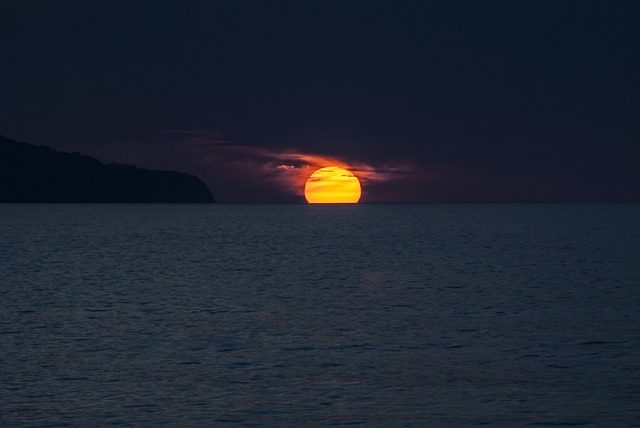
Solar winds, streams of charged particles constantly emanating from the Sun, shape the environment of the Solar System. These winds interact with planetary magnetic fields, influencing phenomena such as auroras and the erosion of satellite surfaces.
- The Sun as a Navigator
Celestial Navigation: Throughout history, explorers and seafarers have relied on the Sun’s position in the sky as guidance, using its rays to determine direction and time.
Spacecraft Navigation: Modern spacecraft continue to utilize the Sun for navigational purposes, aligning their trajectories using the Sun’s position as a reference point.
Planets of the Solar System
The Solar System is home to a dazzling assortment of planets, each with its own distinct characteristics and allure. From the massive gas giants that dominate the outer reaches to the rocky terrestrial worlds closer to the Sun, these celestial bodies offer a glimpse into the diverse possibilities of planetary formation.
Terrestrial Planets
Within the vast expanse of the Solar System, nestled closest to the radiant embrace of our Sun, lie the terrestrial planets. These innermost gems offer a captivating glimpse into the wonders of planetary formation and the potential for life beyond our terrestrial realm.
Mercury:
As the nearest planet to the Sun, Mercury stands as a testament to the extremes of our celestial neighborhood. With scorching surface temperatures reaching over 800 degrees Fahrenheit (430 degrees Celsius) during the day and plummeting to freezing depths at night, Mercury’s stark conditions present a hostile environment for life as we know it. Despite its inhospitable nature, this rocky planet showcases a rugged beauty, with a surface covered in craters and ancient volcanic plains. One of the most intriguing aspects of Mercury is its peculiar orbit, which defies traditional expectations, creating a gravitational dance with the Sun.
Venus:
Shrouded in an atmosphere composed mainly of carbon dioxide with thick clouds of sulfuric acid, Venus serves as a captivating enigma in our cosmic theater. Often referred to as Earth’s “evil twin,” this terrestrial planet suffers from a runaway greenhouse effect, resulting in an inferno-like surface temperature that can melt lead. Beneath its dense cloud cover lies a geologically active planet with towering volcanic peaks and vast lava plains. Venus’s intriguing characteristics make it a constant source of fascination for astronomers, who strive to understand the factors that led to such a stark contrast with its neighbor, Earth.
Earth:
Our beloved home and the oasis of life in the Solar System, Earth stands as an extraordinary testament to the possibilities of a habitable planet. With its dynamic geology, lush landscapes, and diverse ecosystems, our precious planet teems with life in all its magnificent forms. The Earth’s delicate balance of atmosphere, hydrosphere, and lithosphere has fostered the evolution of an unparalleled diversity of plants, animals, and human civilization. As the only known abode of complex life, Earth is a beacon of hope and a reminder of the potential inherent in our cosmic domain.
Mars:
Dubbed the “Red Planet,” Mars has long captured the imaginations of scientists, science fiction writers, and stargazers alike. This terrestrial planet boasts a landscape adorned with iconic landmarks such as the towering Olympus Mons, the largest volcano in the Solar System, and the vast Valles Marineris, a complex system of deep canyons. Mars bears intriguing signs of a once-watery past, with ancient riverbeds and polar ice caps, fueling speculation about the potential existence of Martian life. The ongoing exploration of Mars continues to unveil its enigmatic secrets, igniting our curiosity and driving us closer to understanding our place in the universe.
Gas Giant Planets
Beyond the terrestrial planets, the Solar System opens up to a realm dominated by colossal giants, known as the gas giant planets. Composed mostly of hydrogen and helium, these majestic celestial bodies hold within their turbulent atmospheres the power to captivate and mystify us. Join us as we embark on a journey to explore the grandeur of these gas giants and uncover the secrets that lie within.
Jupiter
At the forefront of this royal court of gas giants stands Jupiter, a majestic behemoth that commands reverence and awe. With a diameter of almost 11 times that of Earth, Jupiter reigns as the largest planet in not only the Solar System but also in our hearts.
Its atmosphere, shimmering with bands of colorful clouds, swirls in a perpetual dance of turbulence and tranquility. This colossal world is adorned with iconic features, such as the Great Red Spot – a storm of monumental proportions that has raged for centuries. As we delve deeper into Jupiter’s mysteries, we uncover intricate cloud structures, powerful storms, and a captivating system of moons that spark the imagination.
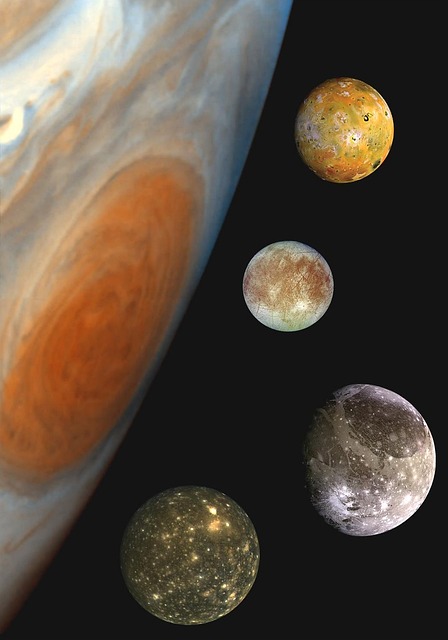
Saturn
In the cosmic tapestry of the Solar System, no planet boasts a more striking allure than Saturn, adorned with its iconic ring system. These rings comprise billions of ice and rock particles, creating a mesmerizing celestial ballet that enchants all who witness it. Beneath the gossamer veils of its rings, Saturn reveals a vibrant atmosphere adorned with intricate cloud bands and swirling storms. Expansive and ethereal, Saturn’s moons – including the enigmatic Titan – beckon us to unlock their enigmatic secrets. As we marvel at Saturn’s beauty, we cannot help but be reminded that within its depths lies a world of immense wonders waiting to be explored.
Uranus
Among the grandiose gas giant planets, Uranus stands apart, boasting a peculiar feature that sets it apart from its siblings – an extreme axial tilt. Unlike the other planets, Uranus tilts so far on its side that it essentially rolls through space. This unique orientation leads to intriguing seasonal variations and a captivating array of atmospheric phenomena. As we delve into Uranus’s frigid atmosphere, we discover a world blanketed in layers of icy hydrogen and helium, interspersed with clouds of methane that give the planet its characteristic blue-green hue. Though often overshadowed by its more prominent siblings, Uranus has a quiet elegance that invites us to explore its enigmatic realm.
Neptune
At the outermost reaches of the Solar System, we find Neptune, a celestial enigma whose icy exterior conceals a world of unimaginable beauty and mysteries. Neptune’s atmosphere is a tempestuous whirlwind of storms and winds, with its most famous feature being the Great Dark Spot – a massive storm system akin to Jupiter’s Great Red Spot. With its captivating blue hue, Neptune exudes an ethereal charm that beckons us to explore its depths. As we uncover the secrets of this ice giant, we encounter its intriguing moons and witness the fierce dance between the planet and its intricate ring system. Neptune, the farthest planet from the Sun, stands as a testament to the wonders that lie within the deepest corners of our Solar System.
Dwarf Planets
While the Solar System’s major planets take center stage in our cosmic theater, there exists a fascinating cast of celestial bodies operating in the shadows. These dwarf planets, although lacking the size and spectacle of their larger counterparts, hold within them captivating mysteries that continue to intrigue astronomers and stargazers alike.
Pluto
As the most famous member of the dwarf planet family, Pluto has captured the imagination of generations. Once considered the ninth planet of the Solar System, its reclassification as a dwarf planet in 2006 caused a seismic shift in our understanding of celestial classification. Nestled in the Kuiper Belt, a region beyond Neptune’s orbit, Pluto’s icy surface conceals a wealth of secrets. Its heart-shaped feature, named Tombaugh Regio in honor of its discoverer, Clyde Tombaugh, is a testament to the diverse and dynamic geological processes taking place on this diminutive world. With its complex atmosphere revealing layers of haze and nitrogen frost, Pluto remains an enigmatic outcast, forever challenging our perceptions of what it means to be a planet.
Ceres
The largest object in the asteroid belt between Mars and Jupiter, Ceres occupies a unique position in the Solar System. Officially designated as a dwarf planet in 2006, Ceres boasts a diameter of approximately 590 miles (940 kilometers) and is composed mainly of rock and ice. As the subject of the Dawn mission, NASA’s spacecraft embarked on a journey to unravel the mysteries of Ceres, capturing stunning images of its cratered surface, icy plains, and intriguing bright spots. Through its exploration, scientists hope to shed light on the formation and evolution of these small, fascinating worlds.
Eris
Discovered in 2005, Eris caused a sensation in the astronomical community. This icy dwarf planet, located in the distant reaches of the Solar System’s Kuiper Belt, holds a diameter slightly larger than Pluto’s. Eris is shrouded in mystery, with a tenuous atmosphere of nitrogen and methane surrounding its freezing surface. Its discovery also played a pivotal role in the reclassification of Pluto, paving the way for a new understanding of the dynamic nature of our cosmic neighborhood. Eris, with its distant allure, serves as a reminder of the vastness and complexity that lies beyond the realm of our everyday experience.
Haumea
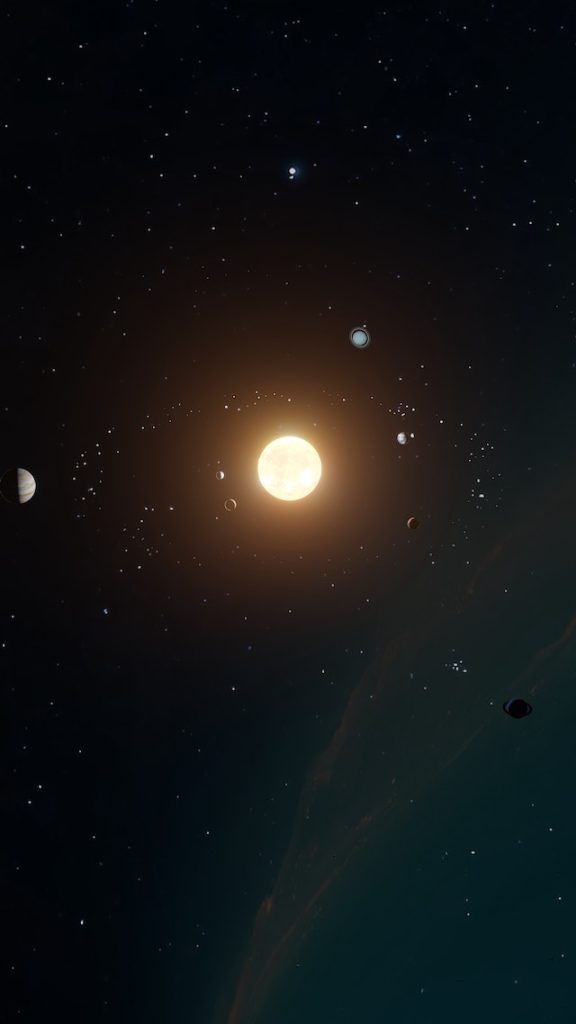
Named after the Hawaiian goddess of childbirth, Haumea boasts an oblong shape and a rapid rotation that sets it apart from its fellow dwarf planets. This elongated body, located in the Kuiper Belt, completes a full rotation in just under 4 hours, giving it a distinct flattened appearance. The cause of Haumea’s unusual shape is believed to be a result of its rapid spin, which has caused the dwarf planet to stretch and flatten over time. Haumea’s unique characteristics continue to puzzle and intrigue scientists, making it a tantalizing object of study in the exploration of the Solar System’s plethora of dwarf planets.
Moons
As we traverse the vast expanse of the Solar System, we encounter a celestial phenomenon that adds an extra layer of majesty and intrigue to our cosmic theater – moons. Each planet within our system boasts a retinue of these captivating satellites, each with its own unique characteristics and stories to tell. Join us as we embark on a journey to explore the diverse and enchanting moons that grace our Solar System.
The Moon
At the forefront of our lunar exploration lies a celestial body that has captivated humanity since the dawn of time – the Moon. Earth’s loyal companion, this magnificent orb shines brightly in our night skies, casting its enchanting glow upon our world. With its rugged surface marked by impact craters, majestic mountain ranges, and vast maria, the Moon serves as a testament to the violent history and geological complexities of the cosmos. It has been a target of human curiosity and exploration, propelling us to set foot on its dusty surface and unveil its lunar secrets. Through the lenses of telescopes and the boots of astronauts, we have gazed upon the Moon, pondering its origins and embracing its profound beauty.
Mars Moons
As we venture further into the realm of moons, we encounter the enigmatic satellites of Mars – Phobos and Deimos. These diminutive moons, named after the sons of the Greek god Ares, stand as silent witnesses to the Red Planet’s tumultuous past. Phobos, the larger of the two, orbits Mars at an alarmingly low altitude, showcasing its celestial ballet as it races across the Martian sky. With its irregular shape and marred surface, Phobos exhibits signs of its impending fate – spiraling ever closer to Mars due to gravitational forces. Deimos, on the other hand, glides serenely through space, its distant orbit lending an air of tranquility to the Martian system. These Martian companions provide astronomers with invaluable insights into the geological and orbital dynamics that shape our Solar System.
Jovian Moons
In the presence of the gas giant Jupiter, we are greeted by a mesmerizing ensemble of moons – a grand dance of giants. These celestial bodies, numbering in the dozens, each possess their own mystique and allure, fuelling our fascination with the secrets they hold. Io, the innermost of Jupiter’s moons, plays host to the most tumultuous volcanic activity in the entire Solar System, with its surface scarred by fiery eruptions that paint the night sky with celestial fireworks. Europa, nestled beneath an icy shell, tantalizes scientists with the possibility of a subsurface ocean teeming with potential for life. Ganymede, the largest moon in the Solar System, boasts a complex interior structure and a distinctive terrain sculpted by ancient tectonic forces. And Callisto, cloaked in a primeval landscape marked by massive impact craters, whispers tales of the distant past. Together, these Jovian moons weave a story of celestial wonder, reflecting the grandeur and celestial dynamics that shape our cosmic neighborhood.
Titan
As we journey towards the ringed planet, Saturn, we encounter the enigmatic moon Titan – a place shrouded in mystery and intrigue. This ethereal satellite, enveloped in a dense atmosphere of nitrogen and smog, boasts a landscape that mirrors Earth’s. Titan’s hazy orange skies and vast, methane-filled lakes beckon us to peer beneath its veil and consider the potential for extraterrestrial life. With its rich organic chemistry, Titan offers tantalizing clues about the building blocks of life and the possibilities that lie beyond our planet. It is a testament to the diversity and complexity of the moons that grace our celestial stage.
Asteroids and Meteoroids
In the vast expanse of the Solar System, we encounter a multitude of smaller celestial bodies that offer a fascinating window into the dynamic nature of our cosmic neighborhood. Among these captivating entities are asteroids and meteoroids, remnants from the early stages of planetary formation.
Asteroids
Asteroids are rocky fragments that orbit the Sun, primarily found in the asteroid belt between Mars and Jupiter. These remnants are believed to be the building blocks of planets that formed during the early stages of the Solar System’s evolution.
Asteroids come in all shapes and sizes, ranging from small rocky bodies measuring a few meters across to dwarf planet-like objects several hundred kilometers in diameter. Their composition varies, with some asteroids consisting of primarily rocky materials, while others contain a mix of rocks, metals, and even organic compounds.
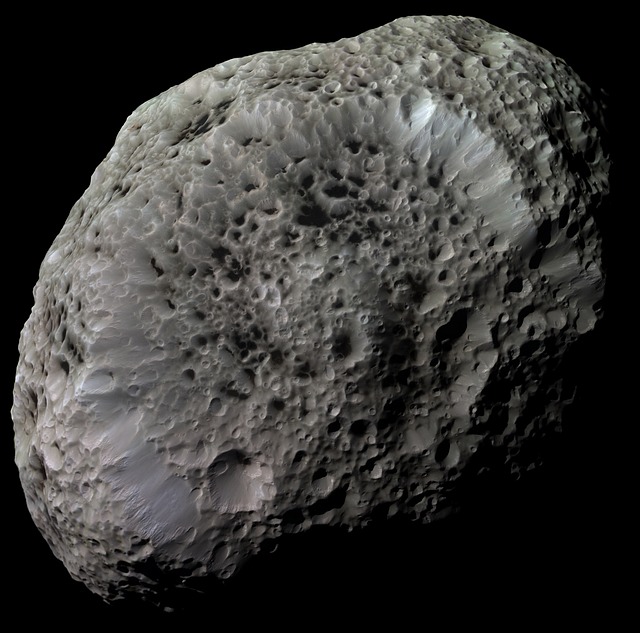
Space missions such as NASA’s Dawn and JAXA’s Hayabusa have ventured to asteroids, providing invaluable insights into their composition and formation processes. These missions have gathered data that challenge theories, revealing surprising diversity among these ancient celestial remnants.
Although most asteroids pose no immediate threat to Earth, the discovery of Near-Earth Asteroids (NEAs) has prompted efforts to detect, track, and mitigate potential impacts through programs like NASA’s Planetary Defense Coordination Office.
Meteoroids
Meteoroids are fragments of asteroids, comets, or even lunar rocks that float through space. They can range in size from a grain of sand to several meters in diameter and are defined by their path through the Solar System.
When a meteoroid enters Earth’s atmosphere and vaporizes, it creates a streak of light known as a meteor or shooting star. Meteor showers, such as the famous Perseids and Leonids, occur when Earth passes through debris trails left by comets and asteroids.
In rare cases, larger meteoroids survive their fiery journey through the atmosphere and impact the Earth’s surface, creating impact craters. These craters provide geological records of past cosmic events and can offer insights into the history of our planet.
Spacecraft like NASA’s Stardust and ESA’s Rosetta have rendezvoused with comets, collecting samples of dust and gas, shedding light on the composition and structure of these ancient celestial travelers.
The Solar System is a captivating realm of celestial wonder that has captivated humanity for centuries. From the majestic Sun at its center to the enigmatic dwarf planets and awe-inspiring moons that adorn its expanse, each celestial body holds within it a wealth of mysteries waiting to be unraveled. Through the disciplined gaze of astronomers and the intrepid explorations of space missions, we continue to unveil the secrets of our cosmic neighborhood and expand the boundaries of human knowledge. The Solar System stands as a testament to the grandeur and complexity of the universe, inviting us to embrace the wonders that lie beyond our terrestrial realm and inspiring future generations to embark on their own voyages of discovery.
